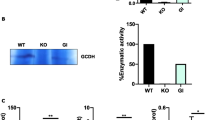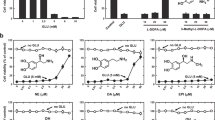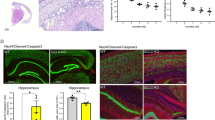Abstract
Glutaryl-CoA dehydrogenase deficiency is an inherited metabolic disease characterized by elevated concentrations of glutaric acid (GA) and its metabolites glutaconic acid (GC) and 3-hydroxy-glutaric acid (3-OH-GA). Its hallmarks are striatal and cortical degeneration, which have been linked to excitotoxic neuronal cell death. However, magnetic resonance imaging studies have also revealed widespread white matter disease. Correspondingly, we decided to investigate the effects of GA, GC, and 3-OH-GA on the rat immature oligodendroglia cell line, OLN-93. For comparison, we also exposed the neuroblastoma line SH-SY5Y and the microglia line BV-2 to GA, GC, and 3-OH-GA. Cell viability was measured by metabolism of 3-(4,5-dimethylthiazol-2-yl)-2,5-diphenyl tetrazolium. Flow cytometry was used to assess apoptosis via annexin-V, anti-active caspase-3 antibody, and propidium iodide staining. GA, GC, and 3-OH-GA reduced OLN-93 oligodendroglia cell viability in a dose-dependent manner. Toxicity of GA, GC, and 3-OH-GA was abrogated by preincubation with the pan-caspase inhibitor z-VAD-fmk. Apoptosis but not necrosis was detected at various stages (early: annexin-V; effector: caspase-3) after 24–48 h of incubation with GA, GC, or 3-OH-GA in OLN-93 but not in neuroblastoma or microglia cells. OLN-93 lacked expression of N-methyl-d-aspartate receptors, making classical glutamatergic excitotoxicity an unlikely explanation for the selective toxicity of GA, GC, and 3-OH-GA for OLN-93 cells. GA, GC, and 3-OH-GA directly initiate the apoptotic cascade in oligodendroglia cells. This mechanism may contribute to the white matter damage observed in glutaryl-CoA dehydrogenase deficiency.
Similar content being viewed by others
Log in or create a free account to read this content
Gain free access to this article, as well as selected content from this journal and more on nature.com
or
Abbreviations
- GA:
-
glutaric acid
- GC:
-
glutaconic acid
- GDD:
-
glutaryl-CoA dehydrogenase deficiency
- GYKI:
-
4-(8-Methyl-9H-1,3-dioxolo[4,5-h][2,3]benzodiazepin-5-yl)-benzenamine hydrochloride
- MK801:
-
dizocilpine
- MRI:
-
magnetic resonance imaging
- MTT:
-
3-(4,5-dimethylthiazol-2-yl)-2,5-diphenyl tetrazolium
- NMDA:
-
N-methyl-d-aspartate
- 3-OH-GA:
-
3-hydroxy-glutaric acid
References
Hoffmann GF, Athanassopoulos S, Burlina AB, Duran M, de Klerk JB, Lehnert W, Leonard JV, Monavari AA, Müller E, Muntau AC, Naughten ER, Plecko-Starting B, Superti-Furga A, Zschocke J, Christensen E 1996 Clinical course, early diagnosis, treatment, and prevention of disease in glutaryl-CoA dehydrogenase deficiency. Neuropediatrics 27: 115–123
Kölker S, Ahlemeyer B, Krieglstein J, Hoffmann GF 1999 3-Hydroxyglutaric and glutaric acids are neurotoxic through NMDA receptors in vitro. J Inherit Metab Dis 22: 259–262
Ullrich K, Flott-Rahmel B, Schluff P, Musshoff U, Das A, Lucke T, Steinfeld R, Christensen E, Jakobs C, Ludolph A, Neu A, Roper R 1999 Glutaric aciduria type I: pathomechanisms of neurodegeneration. J Inherit Metab Dis 22: 392–403
Kölker S, Ahlemeyer B, Krieglstein J, Hoffmann GF 2001 Contribution of reactive oxygen species to 3-hydroxyglutarate neurotoxicity in primary neuronal cultures from chick embryo telencephalons. Pediatr Res 50: 76–82
Latini A, Borba Rosa R, Scussiato K, Llesuy S, Bello-Klein A, Wajner M 2002 3-Hydroxyglutaric acid induces oxidative stress and decreases the antioxidant defenses in cerebral cortex of young rats. Brain Res 956: 367–373
de Oliveira Marques F, Hagen ME, Pederzolli CD, Sgaravatti AM, Durigon K, Testa CG, Wannmacher CM, de Souza Wyse AT, Wajner M, Dutra-Filho CS 2003 Glutaric acid induces oxidative stress in brain of young rats. Brain Res 964: 153–158
Brismar J, Ozand PT 1995 CT and MR of the brain in glutaric acidemia type I: a review of 59 published cases and a report of 5 new patients. AJNR Am J Neuroradiol 16: 675–683
Soffer D, Amir N, Elpeleg ON, Gomori JM, Shalev RS, Gottschalk-Sabag S 1992 Striatal degeneration and spongy myelinopathy in glutaric acidemia. J Neurol Sci 107: 199–204
Bahr O, Mader I, Zschocke J, Dichgans J, Schulz JB 2002 Adult onset glutaric aciduria type I presenting with a leukoencephalopathy. Neurology 59: 1802–1804
Koeller DM, Woontner M, Crnic LS, Kleinschmidt-DeMasters B, Stephens J, Hunt EL, Goodman SI 2002 Biochemical, pathologic and behavioral analysis of a mouse model of glutaric acidemia type I. Hum Mol Genet 11: 347–357
Richter-Landsberg C, Heinrich M 1996 OLN-93: a new permanent oligodendroglia cell line derived from primary rat brain glial cultures. J Neurosci Res 45: 161–173
McKinnon RD, Matsui T, Dubois-Dalcq M, Aaronson SA 1990 FGF modulates the PDGF-driven pathway of oligodendrocyte development. Neuron 5: 603–614
Raff MC, Lillien LE, Richardson WD, Burne JF, Noble MD 1988 Platelet-derived growth factor from astrocytes drives the clock that times oligodendrocyte development in culture. Nature 333: 562–565
Back SA, Gan X, Li Y, Rosenberg PA, Volpe JJ 1998 Maturation-dependent vulnerability of oligodendrocytes to oxidative stress-induced death caused by glutathione depletion. J Neurosci 18: 6241–6253
Kettritz R, Xu YX, Faass B, Klein JB, Müller EC, Otto A, Busjahn A, Luft FC, Haller H 2000 TNF-α-mediated neutrophil apoptosis involves Ly-GDI, a Rho GTPase regulator. J Leukoc Biol 68: 277–283
Bührer C, Atzpodien J, Öz S, Henze G 1991 Fosfomycin does not reduce cytostatic activity of cis-platinum against human osteosarcoma cell lines in vitro. Pediatr Hematol Oncol 8: 243–249
Kölker S, Ahlemeyer B, Krieglstein J, Hoffmann GF 2000 Maturation-dependent neurotoxicity of 3-hydroxyglutaric and glutaric acids in vitro: a new pathophysiologic approach to glutaryl-CoA dehydrogenase deficiency. Pediatr Res 47: 495–503
Kölker S, Ahlemeyer B, Krieglstein J, Hoffmann GF 2000 Cerebral organic acid disorders induce neuronal damage via excitotoxic organic acids in vitro. Amino Acids 18: 31–40
Kavanaugh B, Beesley J, Itoh T, Itoh A, Grinspan J, Pleasure D 2000 Neurotrophin-3 (NT-3) diminishes susceptibility of the oligodendroglial lineage to AMPA glutamate receptor-mediated excitotoxicity. J Neurosci Res 60: 725–732
McDonald JW, Althomsons SP, Hyrc KL, Choi DW, Goldberg MP 1998 Oligodendrocytes from forebrain are highly vulnerable to AMPA/kainate receptor-mediated excitotoxicity. Nat Med 4: 291–297
Bjugstad KB, Zawada WM, Goodman S, Free CR 2001 IGF-1 and bFGF reduce glutaric acid and 3-hydroxyglutaric acid toxicity in striatal cultures. J Inherit Metab Dis 24: 631–647
Palmeira CM, Rana MI, Frederick CB, Wallace KB 2000 Induction of the mitochondrial permeability transition in vitro by short-chain carboxylic acids. Biochem Biophys Res Commun 272: 431–435
Newmeyer DD, Ferguson-Miller S 2003 Mitochondria: releasing power for life and unleashing the machineries of death. Cell 112: 481–490
Jouvet P, Rustin P, Taylor DL, Pocock JM, Felderhoff-Müeser U, Mazarakis ND, Sarraf C, Joashi U, Kozma M, Greenwood K, Edwards AD, Mehmet H 2000 Branched chain amino acids induce apoptosis in neural cells without mitochondrial membrane depolarization or cytochrome c release: implications for neurological impairment associated with maple syrup urine disease. Mol Biol Cell 11: 1919–1932
Kagawa T, Wada T, Ikenaka K 2001 Regulation of oligodendrocyte development. Microsc Res Tech 52: 740–745
Levison SW, Goldman JE 1993 Both oligodendrocytes and astrocytes develop from progenitors in the subventricular zone of postnatal rat forebrain. Neuron 10: 201–212
Monavari AA, Naughten ER 2000 Prevention of cerebral palsy in glutaric aciduria type 1 by dietary management. Arch Dis Child 82: 67–70
Hardy R, Reynolds R 1993 Neuron-oligodendroglial interactions during central nervous system development. J Neurosci Res 36: 121–126
Kölker S, Okun JG, Ahlemeyer B, Wyse AT, Hörster F, Wajner M, Kohlmüller D, Mayatepek E, Krieglstein J, Hoffmann GF 2002 Chronic treatment with glutaric acid induces partial tolerance to excitotoxicity in neuronal cultures from chick embryo telencephalons. J Neurosci Res 68: 424–431
Silva CG, Silva AR, Ruschel C, Helegda C, Wyse AT, Wannmacher CM, Dutra-Filho CS, Wajner M 2000 Inhibition of energy production in vitro by glutaric acid in cerebral cortex of young rats. Metab Brain Dis 15: 123–131
Forstner R, Hoffmann GF, Gassner I, Heideman P, De Klerk JB, Lawrenz-Wolf B, Döringer E, Weiss-Wichert P, Tröger J, Colombo JP, Plöchl E 1999 Glutaric aciduria type I: ultrasonographic demonstration of early signs. Pediatr Radiol 29: 138–143
Lin SK, Hsu SG, Ho ES, Tsai CR, Hseih YT, Lo FC, Lai HY, Chen MH 2002 Glutaric aciduria (type I): prenatal ultrasonographic findings. Ultrasound Obstet Gynecol 20: 305–307
Acknowledgements
We thank Evelyn Strauss for excellent technical assistance and Dr. D. Stibenz for helpful discussion.
Author information
Authors and Affiliations
Corresponding author
Additional information
Supported in part by grants from the German Federal Department of Education and Research (BMBF, 01 ZZ 0101), Bonn, and the Wilhelm Sander Stiftung (2000.091.1), Munich.
Presented in part at the annual meeting of the European Society for Pediatric Research; Bilbao, Spain, September 2003.
Rights and permissions
About this article
Cite this article
Gerstner, B., Gratopp, A., Marcinkowski, M. et al. Glutaric Acid and Its Metabolites Cause Apoptosis in Immature Oligodendrocytes: A Novel Mechanism of White Matter Degeneration in Glutaryl-CoA Dehydrogenase Deficiency. Pediatr Res 57, 771–776 (2005). https://doi.org/10.1203/01.PDR.0000157727.21503.8D
Received:
Accepted:
Issue date:
DOI: https://doi.org/10.1203/01.PDR.0000157727.21503.8D
This article is cited by
-
Long Lasting High Lysine Diet Aggravates White Matter Injury in Glutaryl-CoA Dehydrogenase Deficient (Gcdh−/−) Mice
Molecular Neurobiology (2019)
-
Oxygen impairs oligodendroglial development via oxidative stress and reduced expression of HIF-1α
Scientific Reports (2017)
-
Kynurenic Acid Induces Impairment of Oligodendrocyte Viability: On the Role of Glutamatergic Mechanisms
Neurochemical Research (2017)
-
1H‐MRS in glutaric aciduria type 1: impact of biochemical phenotype and age on the cerebral accumulation of neurotoxic metabolites
Journal of Inherited Metabolic Disease (2015)
-
White Matter Injury Induced by Perinatal Exposure to Glutaric Acid
Neurotoxicity Research (2014)



